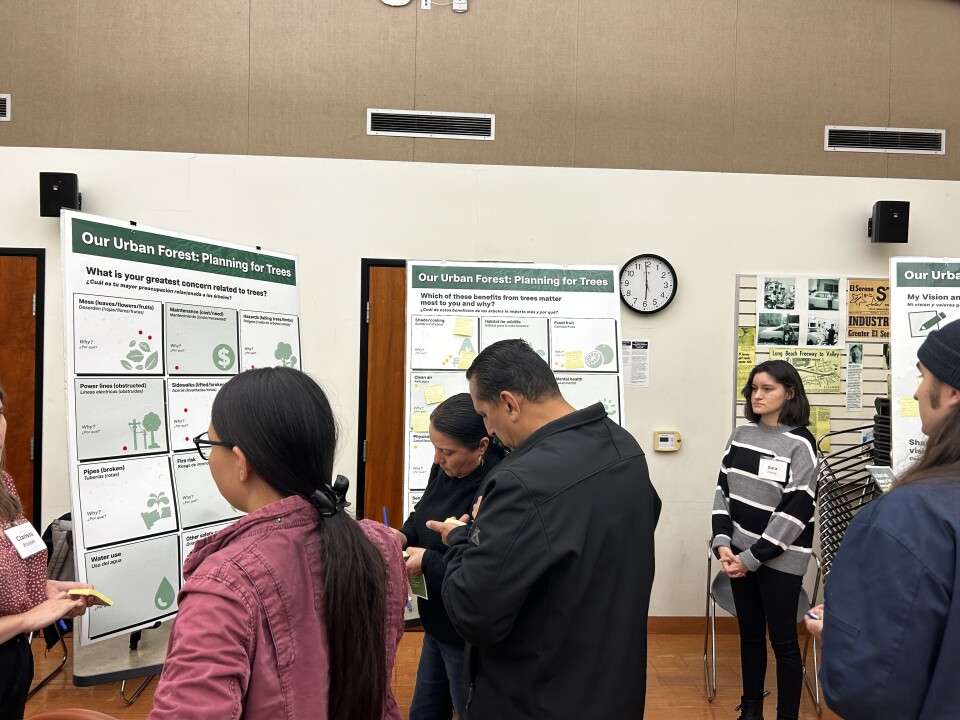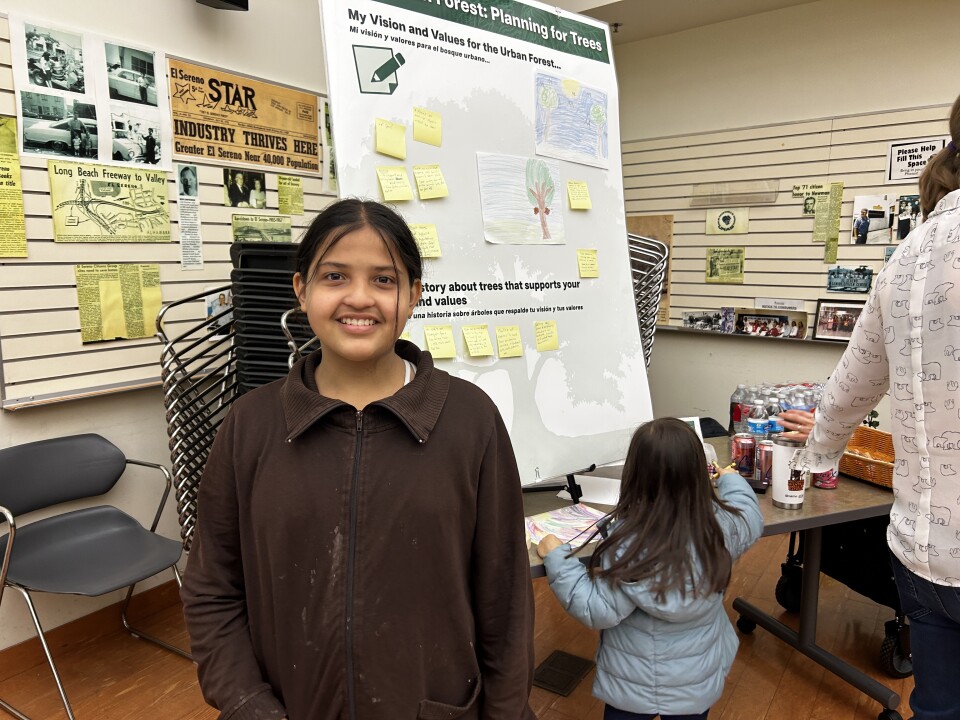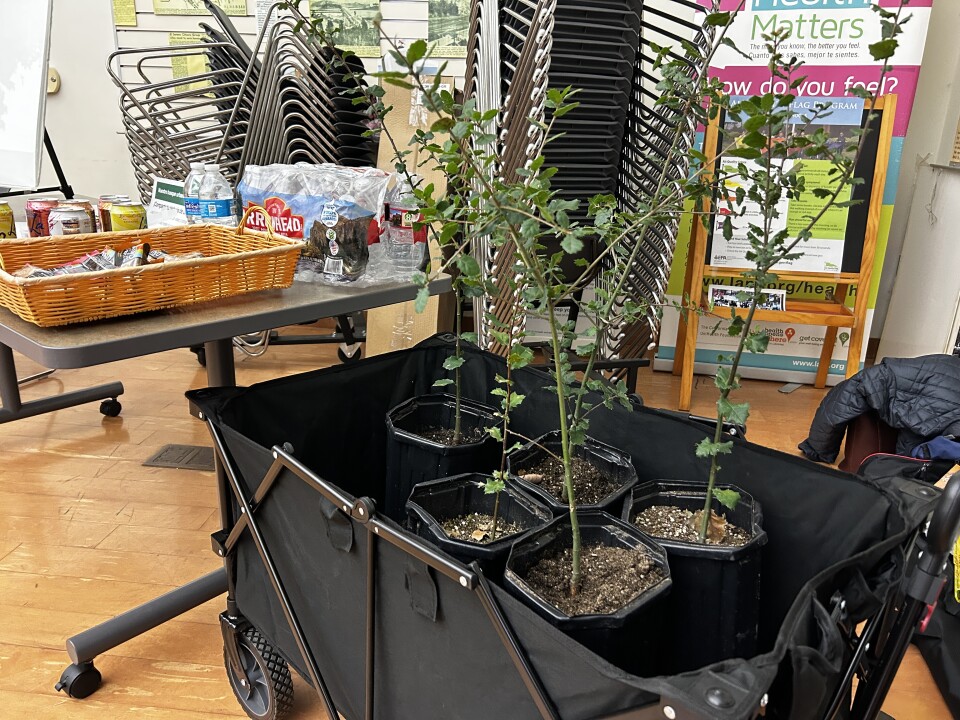Truth matters. Community matters. Your support makes both possible. LAist is one of the few places where news remains independent and free from political and corporate influence. Stand up for truth and for LAist. Make your tax-deductible donation now.
Want To Have A Say In The Future Of LA’s Trees? Here’s How

The city and county of L.A. are in the midst of gathering insights from community members across the region about what they want to see when it comes to trees in their neighborhoods.
It’s part of an effort to create the region’s first holistic and long-term plan to manage our urban forest amid a changing climate. The goal is to eventually rectify the legacy of unequal tree canopy that resulted from past racist housing policies, called redlining, as well as boost community resilience in the face of human-caused climate change.
How to participate
The city and county have hosted engagement workshops since January to hear from residents about trees in their neighborhoods. The remaining workshops, some of which are in-person while others are virtual, run through early March. You can find a list of them here (check back too, since some workshops are still being scheduled). You can also submit comments via this questionnaire.
The county’s draft plan is expected to be released and open to public comment in late March. The city aims to have its draft plan out for public comment by the end of this year. When that happens, you’ll also have a chance to voice your comments and concerns.
You can keep up with updates on the county plan’s progress by signing up for their newsletter here or follow them on X @CSO_LACo. For updates from the city, bookmark the Office of Forest Management’s website or follow them on X @LACityDPW.
How this effort is funded
The workshops are funded by two $1.5 million grants from the California Department of Forestry and Fire Protection, or Cal Fire, awarded to both the city and county. An $8 million dollar grant from the federal Inflation Reduction Act, or IRA, will be used to implement the county's plan. Two grants adding up to $8 million will also fund tree-planting efforts in the city. The county plans to complete its urban forest plan by summer, and the city aims to complete its plan by early next year.
What the workshops are like
At one of the city’s recent workshops at the El Sereno library, a dozen or so folks gathered to learn about the plan’s goals and share their thoughts. The city set up poster boards with questions asking what people value about trees, as well as what concerns they have. People wrote down thoughts and suggestions on sticky notes and placed them on the poster boards to indicate what they valued or were concerned about when it comes to trees.
Many folks wrote about the need for more trees at local schools, as well as issues maintaining existing trees. For example, El Sereno has many ficus, jacaranda and other large trees that drop lots of plant matter and have roots that break up sidewalks and streets.

El Sereno resident and teacher Yolie Garcia said she wanted to see more trees at schools and local parks, as opposed to large parkways, but she was concerned about the maintenance of existing trees and their impact on infrastructure.
“I remember walking along Huntington Drive with the stroller and at times I couldn't walk on the sidewalks [because of roots breaking them up],” she said. “I had to get off and walk on the streets and then I have to be watching out for traffic. And we've had students who fall and scrape themselves because of the broken sidewalks.”
She was also concerned with budget cuts and the money needed to carry out efforts to maintain and plant more trees.
“We would like trees that will beautify our community, bring great benefits as far as mental health, but we just want to make sure that they are the right trees that will require low maintenance,” she said.

Danielle Ruby Nava, 12, said she loves the trees where she lives in El Sereno because they relax her, clean the air and are beautiful.
”We have fruit trees, avocado trees,” she said. “I like to look at them a lot because they're pretty. When it rains, it smells good. That's when we open the windows and let the air come in.”
But she wants to see more trees at her elementary school. She said during recess she always tries to hang out with her friends beneath the few trees around the blacktop playground because of their shade and calming effect. In the summer, she said it gets so hot, it’s hard to run and play because of the lack of shade.
Read more about the efforts to green schools
The challenge of creating a thriving urban forest
The concerns about maintenance of existing trees and the personal connection to certain trees are major themes emerging from the workshops across the region, said Rebecca Ferdman, policy director with the L.A. County Chief Sustainability Office, which is in charge of developing the county’s urban tree plan.

She said it’s not as simple as just planting more trees. For example, areas with the least tree canopy tend to be denser, and more paved. That makes it more expensive to plant trees because you need to break ground. There’s also the issue of soil health when you do break up that pavement.
And it’s more complicated to choose the right species that provide significant shade without impacting infrastructure — for example, trees that provide a lot of shade, such as native oak trees, when fully grown have strong roots that can break up pavement and disrupt underground utilities. More extreme storms are felling more trees too, which can take out power lines and damage homes.
“It’s a lot more difficult and more expensive to do it in the places where we really need to do it,” Ferdman said.
Learn more about green infrastructure
And how to advocate for it in your neighborhood here.
Some solutions the county may consider, based on community input, are prioritizing preserving our oldest and largest trees, as well as investing in other types of “green infrastructure” in areas that may have less space for such trees, such as curb planters and possibly vine canopies over sidewalks.
There’s also the question of what types of trees will thrive in a drier, hotter future — and the science is still preliminary on that front.
“We can only expect more extremity and more uncertainty in the future, and so we have to be focusing on trees that we think will do well now, which are already different than trees 50 years ago,” said Ferdman.
Native trees as well as drought-tolerant trees from other parts of the world will need to be prioritized, Ferdman said.
And preserving existing tree canopy is also proving to be an increasing challenge. One example, Ferdman said, is the ubiquitous magnolia tree — it can provide lots of shade, but has always required significant supplemental irrigation to survive in our dry climate. Now, amid increasingly extreme heat and severe droughts, supplemental irrigation is proving not to be enough to sustain it. During the recent storms, we saw many trees in canopy-rich areas fall or lose branches and take out power lines and damage homes. And trees and plants may be losing their ability to cool neighborhoods as much as they have in the past, because they’re struggling to adapt to the pace at which our climate is warming, according to a recent study from UC Riverside.
Learn more about the future of trees in a drier, hotter future
Answering those questions about what trees are best for different parts of the county — which span from coastal and chaparral ecosystems to the high desert — is key because experts agree trees remain a necessary piece of the puzzle to increase our resilience to climate change and improve quality of life.
Trees not only beautify neighborhoods, boost mental health, and provide healthy fruits, but they also clean the air, capture and slow stormwater, and provide much-needed shade and cooling as extreme heat worsens.
Ultimately, some of these decisions may come down to the tradeoffs and risks we’re willing to accept to live with more trees, said Rachel Malarich, L.A. city’s forest officer.
“If a tree falls in the forest, it decays on the ground. Here, if it falls over, it lands on someone's car or causes a problem,” she said, “and so it's that interaction between trees, nature, and people that is what makes it so complicated.”








